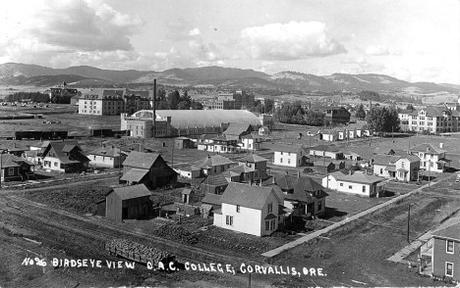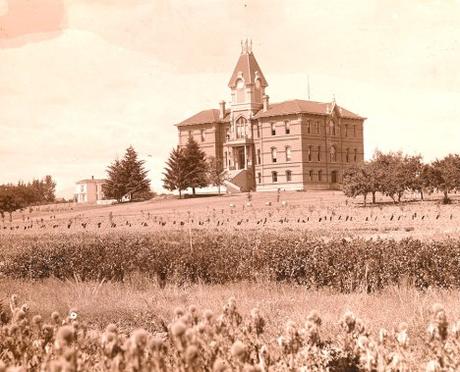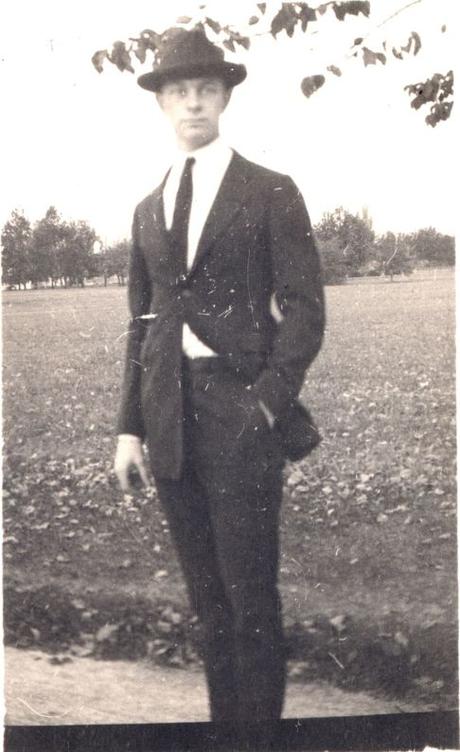
OAC rooks running through a large O at Bell Field, 1914.
[Ed Note: Today is the first day of Fall classes here at Oregon State University, and this month also marks the one-hundredth anniversary of Linus Pauling’s enrollment at what was then known as Oregon Agricultural College. Today’s post is part 1 of 4 examining the school that Pauling attended for his undergraduate education as well as the ways in which Pauling navigated life as a “rook” on campus.]
In the fall of 1917, a newcomer to Oregon Agricultural College, such as incoming freshman Linus Pauling, would have encountered a lively student population housed in commanding buildings. This same newcomer would likewise come into contact with a campus bustling with wartime activity and on the cusp of precipitous change.
From humble beginnings, OAC had, by 1917, developed into an institution admired by the bulk of Oregon’s residents — even those supporting the College’s rival, forty-five miles to the south. The College, by now steeped in the Land Grant tradition that had energized state schools across the country, sought to educate students, conduct research and, importantly, foster a connection with Oregon’s communities.
By the time that Pauling arrived, the campus infrastructure consisted of 349 acres, 91 of them constituting the main campus. The remaining acreage, located just outside the Corvallis city limits, formed areas for studying and maintaining livestock, poultry, and horticulture. At the time, the community boasted of 6,000 residents, “free mail delivery…many churches and no saloons.” Living in a city that derived its name from the Latin for “heart of the valley”, members of the OAC community took great pride in their scenic surroundings.

The OAC campus as it looked in 1911.
During this period, the Administration Building (known now Benton Hall) served as the centerpiece of campus. Funded by the local townspeople as a show of support once OAC had received its federal land grant, the Administration Building was completed in 1889 and still stands today, the oldest building on Oregon State’s campus.

Present-day Benton Hall, 1889.
To accommodate growing numbers of students and faculty, the number of buildings populating OAC’s campus increased each year, with 1917 being no exception. Specifically, the fall of 1917 saw the unveiling of the Forestry Building, now known as Moreland Hall, and its completion brought the total number of buildings on the OAC campus to thirty-six. Other notable structures of the era included the Agriculture Building (now Strand Agricultural Hall)—the largest edifice on campus at the time—the Dairy Building (now Gilkey Hall), the Home Economics Building (now Milam Hall), and Science Hall (present-day Furman Hall), all of which had been constructed in recent years.
The College was clearly growing. And yet, despite these developments, Corvallis remained a rural community in spirit, while Oregon Agricultural College, as the name suggests, was largely agrarian in its focus, with secondary emphasis paid to all manner of practical skill-building.
Tuition at Oregon Agricultural College did not exist. Indeed, in a technical sense, the school was free to all, including out of state and international students. That said, there were certain fees dispensed throughout a student’s college experience. Some fees were assessed yearly while others were collected for one-time events, such as graduation.
There were also fees or additional costs associated with particular courses. For example, students were required to purchase “gymnasium suits” for their PE classes, and other fees were mandated for courses incurring laboratory expenses. Between yearly fees, semester fees, and a diploma fee, early twentieth century undergraduates could count on spending at least sixty-one dollars during the time that it took to complete a four-year degree.
With the cost of attendance so low, the principle fiscal concern for students came in the form of room and board costs. Women, who were required to live with family or on campus in either Cauthorn Hall (now Fairbanks Hall) or Waldo Hall, could expect to pay ten to twenty dollars per semester for rooming, depending on whether they chose a single or a double room. Male students, for whom no campus housing was available, could find lodging in private homes for approximately sixteen to twenty dollars a month, culminating in a yearly expense that might approach two-hundred dollars at the high end. Excluding funds for transportation, amusement, and other needs, such as clothing, a year at OAC was estimated to cost men between $346.20 – $401.20, and women $107.00 – $227.00.

Pauling on campus, 1917
For Linus Pauling, who came from a humble background, finances were a great and continuing concern throughout his first year of college. In the diary that he maintained for much of the year, he meticulously tracked his spending habits in an effort to make every penny count. Before the school year began, he estimated that his expenses would sum to $297. However, by late October – just a month into his first term – he revised his initial approximation, noting
I have spent about $125 already. Board will be $175 more – 300 altogether. Then my numerous expenses will mount up. I do not expect to get off for less than $325.
In its annual catalogs, OAC emphasized that students could earn money for food and housing by working for a few hours every week. More specifically, according to the College, a student could work three hours a day for room expenses and four hours a day to cover both room and board costs. Administrative work and stenography were preferred by students, rendering these jobs in high demand.
To aid in the job searching process, the College provided a Student Employment Bureau. In highlighting this service, the College catalog took pains to stress that “no student should come expecting to earn money if he can do nothing well; skill is essential, as competition is quite severe in the College community as elsewhere.”
Advertisements